I have been drinking a lot of grape juice made from wild grapes growing in the neighborhood. I like the tart flavor of the unsweetened grapes. It has what I would call a non-traditional flavor profile. In other words not the typical formula of sugar+water+flavor (and optionally caffeine) that makes up 99% of drink options at the gas station. After making enough juice, I couldn't help but try to turn some of it into wine.
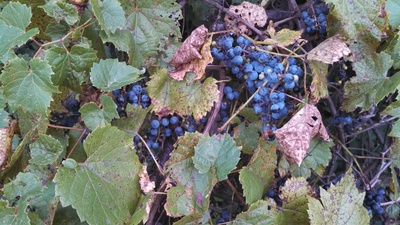
Making Juice
I make the juice by fetching grapes, pulling the grapes off the stems into a bowl, rinsing, and straining. The grapes go into a pot on the stove where I squeeze them by hand (or just blend them gently) to help extract the juice then boil the grapes with some water in a pot on the stove. Strain through a nut milk bag, paint strainer, or cheesecloth. Put solids back on the stove, add water, and strain again because there is still a fair amount of juice and flavor left after the first boil. Put the juice in jars. It is highly concentrated, so to make a drink I just put a little bit of juice in a cup and top it off with water. The resulting juice is simple and delicious (if you like tart).
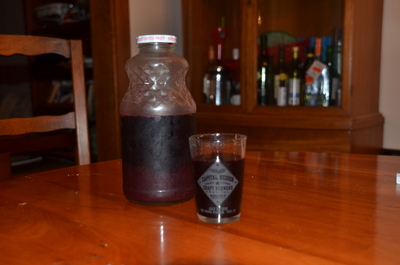
Wine time
I always prefer to start out a project by making all the mistakes first. That way I know why I'm doing everything the right way if it ever comes to that. Plus I'm impulsive and want to complete a project without getting bogged down with learning how to do it first. Where better to start my first winemaking experience than this guy's awesome wine recipe?
The process went something like this:
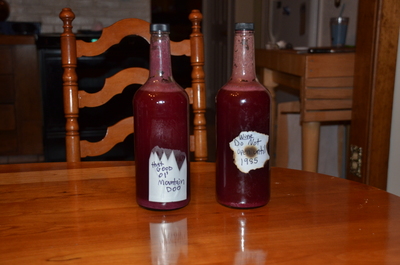
1) Add nearly 1 liter of grapes to blender
2) add 1 liter of water
3) Blend lightly (on setting 3/10) for 45 seconds
4) strained into a pot using nut milk bag
5) put remains back in blender
6) rinsed nut bag into blender
7) blended and strained again to get a little more juice out of the seeds
8) pour seeds out behind the house, maybe they'll turn into vines
9) sterilize spoons, strainer, bottles, (etc.)
10) boil the juice gently for a few minutes
11) to each bottle add 1 part juice, 1.5 part water
12) to each bottle add 1/2 cup sugar plus 1/8 cup
13) put on lid & shake
14) let the juice cool to room temperature (so as not to kill or over-activate the yeast when it goes in)
15) add a little less than a tsp yeast
16) put on lid & shake
17) twist cap on bottle just until it resists twisting a wee bit (so air can escape)
18) put bottles in a dark place
After a few minutes the juice started bubbling and foaming until one of the bottles spurted a bit of juice out the cap. After the foaming subsided I rinsed the bottle. It has now been 24 hours and the yeast and sugar is happily fermenting away. The actively bubbling liquid gives off a bit of a yeasty odor.
9/9 - The other day I poured the wine from both bottles into a sterilized growler and put a legitimate airlock on instead of simply gently twisting the cap on.
Here is a list of potential problems with this batch so I don't forget:
1) These grapes came from the side of a busy road.
2) The wine spent a few days fermenting with an improper airlock
3) Not sure if the quantities of sugar/yeast are at all appropriate
10/2 update: I transferred the wine from the growler to a bottle using a siphon, being careful not to draw the wine from the very bottom where all the yeast sits. I filled a bottle, and there was just enough for a glass left over, so I poured myself a tall one. I think that my ability to taste the wine was biased by the fact that I was horrified by what went into it: it's basically sugar and yeast with a little bit of grapeyness. It didn't taste like a wonderful wine, I'll tell you that much. However, there was nothing particularly foul about it except that it really tasted a lot like fermented sugar water with a bit of grape. Yeasty I suppose. With a bit of a punch. There is a whole bottle of it, I will have to try it again and see if I can perceive the flavor a little better.
Something to try next
I wouldn't mind trying another batch but taking it more seriously this time. I'd like the wine to be made primitively, with nothing but fermented grapes. I imagine that's how it was made 2000 years ago. Adding tons of sugar and yeast seems over-aggressive to me so I'd like to try it this way instead and see what happens.
== Goals ==
1) just grapes - no yeast or sugar added ("spontaneous fermentation")
2) no chemicals
3) no cooking/pasteurizing the grapes
4) no plastic containers - use sterilized glass jugs
5) small batches (growlers for vessels, half-sized wine bottles preferred)
6) low-alcohol is okay (except that low-alcohol wine is more prone to spoilage so aging may prove difficult)
== Notes ==
1) Wild yeast will likely die before alcohol content reaches 6%. High alcohol (usually 12% or more in wine) gives wine its longevity, body and other positive features. Without good alcohol, wine dies quickly.
2) Once fermentation begins with wild yeast, it is longer and slower, and at a lower temperature.
3) It takes up to a week for wild yeast to colonize in larger batches, leaving the grapes open to infection/oxidation.
4) Rain washes yeast off the wild grapes and lingering moisture may contain bacteria so pick the grapes dry, particularly for pied de cuve.
== Stage 1: Buy Stuff ==
1) 2 airlocks with size 6 stopper to fit on growlers, hopefully it can be sterilized w/boiling water
2) 1 siphon tube that can withstand a bit of boiling
3) 1 funnel: nice and wide for pouring chunky must into growler
4) 1 hydrometer - not sure what I'd do with it, but if I knew what I was doing this will be useful
Comment: "Wow this stuff doesn't cost very much. The airlocks are like a buck."
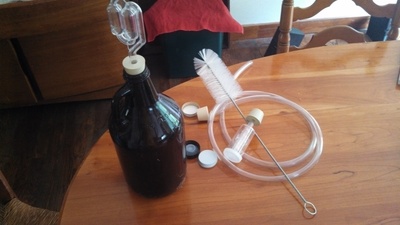
== Stage 2: Pied De Cuve ==
1) fetch a small amount of wild grapes into a sterilized bowl with washed hands, the longer after rain the better
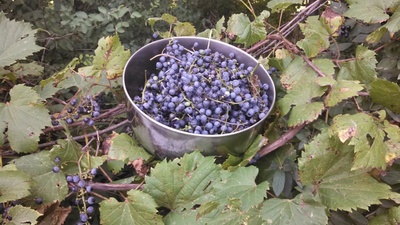
2) wash hands and sterilize: glass bowl, cloth
3) destem grapes to bowl
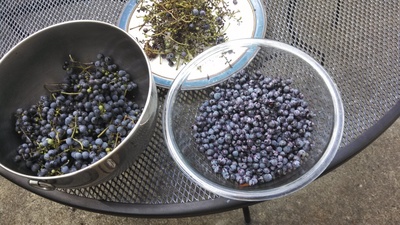
4) crush grapes by hand in bowl
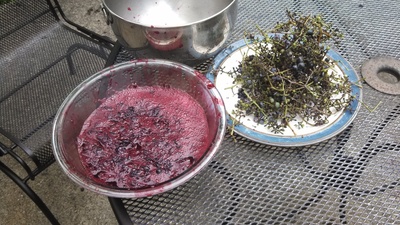
5) leave it out covered with sterilized cloth to gather yeast for 5-10 days. Stir daily-ish with a sterilized spoon. If it starts fermenting (bubbling) and smells ok, use it to innoculate for primary fermentation. Otherwise, buy some wine yeast at the store or try again later.
QUESTIONS: Indoors or outdoors? I'm keeping mine indoors, but it attracts a few fruit flies, but seems fine. How long to keep before adding it to the rest of the project (when is it ready?)? Stir regularly? Add something like more grapes to fuel it occasionally? How does light affect things (right now it's in a clear glass bowl covered with a towel, plus a paper bag over the top of that to keep flies at bay)?
PROGRESS1: I started this on 9/7. It is now the morning of 9/10. Some fruit flies have shown up to the scene. I haven't seen any in the must, but they are around the house and a few try to get at the bowl. It is quite foamy after stirring and bubbles occasionally. It might be time to harvest more grapes and move on to the next step. I just need to determine if I should ferment w/seeds and skins or ferment just juice at this point. I know that how long the skins are kept with the ferment determines how tannic the wine will be.
Here are pictures of the Pied de cuve after 3 days, before and after stirring:
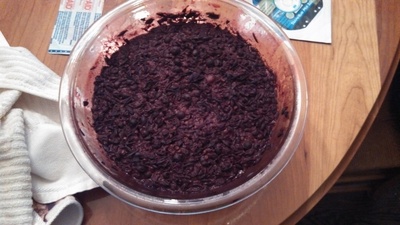

PROGRESS2: It is now the evening of 9/10. When I got home, the must bowl was fermenting quite actively, with lots of bubbles. Here is another pair of pictures, before and after stirring, note that it is quite a bit more bubbly this time:
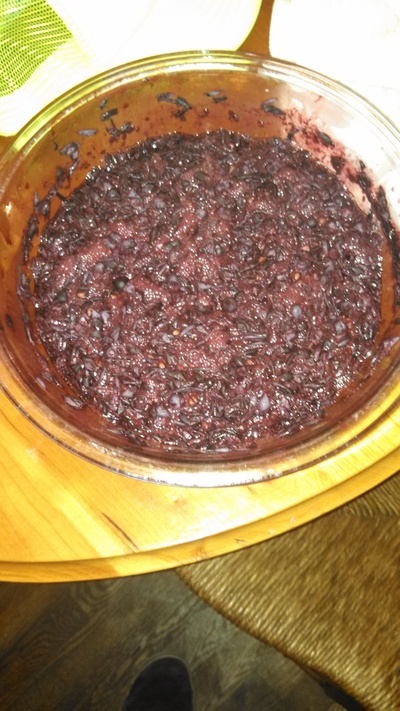
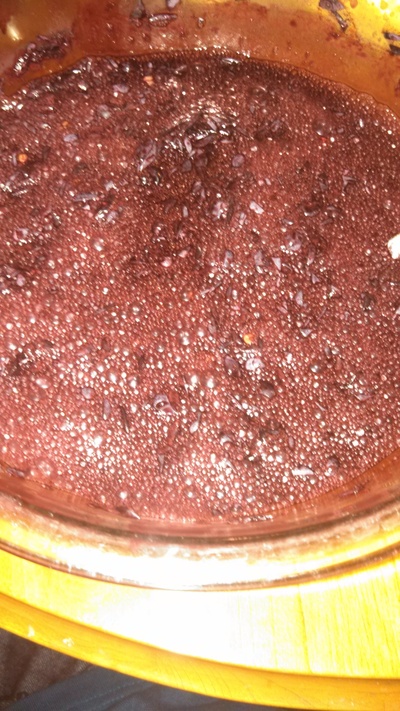
The temperature warmed up quite a bit during the day today, that may have increased the amount of fermentation activity. A dozen or so fruit flies were in the bowl, they had penetrated the two layers of defence: paper bag and towel. The must had the *very* distinct and strong smell of a favorite toxic toy from my youth, Super Elastic Bubble Plastic by Wham-O.
This stuff is made with polyvinyl acetate dissolved in acetone, with ethyl acetate. I wonder what exactly I made here, acetone? As I was sniffing I was thinking rubbing alcohol but that seemed slightly off-target. I knew the smell was that of some small bottle of stuff we keep under the bathroom sink. Yeah, nail polish remover, that's the smell! Chemistry never was one of my strong points. How the f did I make nail polish remover? Anyway, when I die of cancer it's clearly from either too much bubble plastic as a kid or this ill-advised winemaking experiment, which is now heading in a direction I did not foresee. It seems the only reasonable option now is to press forward with the plan and try to find out what is going on.
A little research indicates that acetone is safe to eat! Yay! Talk about non-traditional flavor profiles! To quote Wikipedia:
"Acetone has been rated as a GRAS (Generally Recognized as Safe) substance when present in beverages, baked foods, desserts, and preserves at concentrations ranging from 5 to 8 mg/L. Additionally, a joint U.S-European study found that acetone's 'health hazards are slight.'"
Woot!
Back to business. I now have two airlocks. One is in use and the other airlock is the 2-piece type. It melted a bit when I steam-sterilized it, and when I tried to bend it back into shape it cracked. Sad face. Between the fruit flies and the Bubble Plastic odor, it's probably better that I get this airlocked sooner rather than later. So I phoned a friend to see if he had an extra airlock, but there was no answer. Next step: fashion one out of common household items. I drilled a hole in a rubber stopper (not an easy task), lubed the hole with vegetable oil, and shoved a piece of plastic tubing through it. I confirmed that it is air-tight, then transferred the must to a growler using the new airlock contraption, with the other end of the tube stuffed into a water-filled bottle that will sit next to the growler.
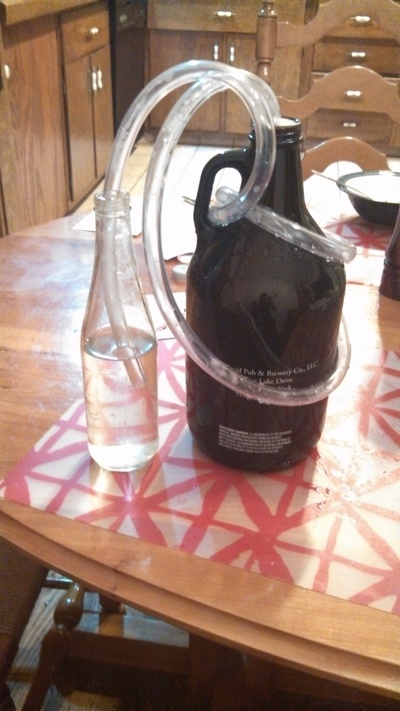
The growler is half full of grapey plasticy seedy must with skins and all. I'm thinking I should simply fill the rest with water, because it probably doesn't need any more grapes. It looks like if there is a next time I will need a larger vessel. Speaking of which, this whole operation with the fruit flies and the fact that the bowl of stuff clearly fermented a lot on it's own, maybe putting the must out covered by a towel isn't necessary, at least not for as long as I left it which was only 3 days. The idea was that it needed to gather natural yeast from the air. Next time I should get grapes after it hasn't rained in a while and just mash 'em up and put them in an airlocked vessel and leave them be and see if that gets started fermenting.
PROGRESS3: A few hours later, the half-and-half must/water mix is fermenting like crazy. Bubbles are blasting out of the airlock. What is going on? This process is a lot less subtle than I ever would have expected. Expansion is happening, maybe just foaming inside the glass container, because juice is pouring through the airlock tube. I poured some out into a glass to reduce the volume of liquid inside the growler.
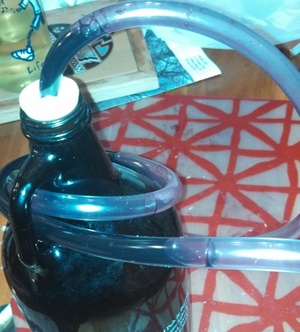
PROGRESS4: The very next day, all fermentation completely stopped.
== Stage 3 Primary Fermentation ==
1) fetch wild grapes with clean hands to a sterilized bowl
2) wash hands and sterilize: bowl, growler, airlock, funnel, plate to hold sterilized stuff
3) destem grapes
4) put grapes in bowl and crush with a clean hand
5) funnel must into growler w/airlock.
6) add water to fill growler to 1/2 inch below neck to leave room for a bit of foaming. Perhaps try 1 part must, 2 parts water.
7) place airlock growler in basement or another dark place.
8) leave it there for 7-14 days (not sure how long this should take).
== Stage 4: Secondary Fermentation ==
1) sterilize second growler, second airlock, siphon, strainer, plate to hold sterilized stuff
2) siphon/strain wine to another growler w/airlock for secondary fermentation. Add water as needed.
3) leave it there for 3 months (not sure how long this should take)
== Stage 5: Bottling ==
1) wash hands, sterilize bottles, caps, siphon
2) siphon wine into bottles & cap.
3) store in a dark place in the basement
NOTE: If there is a problem with bottles exploding or there is unpleasant carbonation, then I should have degassed before bottling.
== Still to plan out ==
1) timing for primary and secondary fermentation
2) bottling - what type of bottles (why not glass bottle & plastic cap?):
- glass chia drink bottles w/plastic cap?
- beer bottles, caps, & capper?
- wine bottles & corks? (I'd like smaller bottles)
3) when to harvest?
- "Supposedly V. Riparia (wild grape) drastically increases its sugar content and lowers it's acid levels after the first frost."
== Variations ==
1) If this fails miserably, use manufactured yeast
2) If this is wildly successful, go more primitive: Clay vessels, that kind of thing. Don't use anything they didn't have 2000 years ago.
== Reference ==
1) http://winemakermag.com/758-wild-yeast-the-pros-and-cons-of-spontaneous-fermentation
2) http://www.paulgregutt.com/2012/07/those-unpredictable-wild-and-authentic.html
Third Attempt
10/12/13
It has been about a week since a heavy rainfall. Today I fetched maybe 5-10 gallons of grapes (with stems on) from the side of a busy road. This amounted to 1.5 gallons of de-stemmed grapes or eventually 1 gallon of grape mush. I added a gallon of water, and the liquid tasted like it might have an appropriate grape concentration. The hydrometer put alcohol potential at 5-6%. I was tempted to add sugar, but decided to go all-natural instead. I put it in a brew bucket and put it in the basement where it is a more appropriate temperature for making wine, it should ferment for a week or two. Then move it to a glass jug for secondary fermentation.
10/19/13
The brew bucket is only about half full. The airlock has not really been bubbling at all. So I thought fermentation was not happening. So 2 days ago I opened it up to take a look inside. It was (and still is) bubbling like boiling water. I stuck my head in the bucket and took a big ol' whiff and almost choked on the stinging smell of nail polish remover.
Someone suggested that I should leave the mixture in the basement where it is cooler. Some of the off-odors may have come from fermenting at too-high a temperature. We did have a bit of a warm spell during the first fermentation.
I had read somewhere that for this first stage of making wine, I should keep the must outdoors tightly covered with a sterilized cloth to keep fruit flies/etc. out. In this case I sealed the must with an airlock instead. The fingernail-polish remover section of the following link poses one possibility that maybe the must needed to be exposed to open air to release these off-smells.
[[http://winemaking.jackkeller.net/problems.asp | Winemaking Problems Web Page]]
Another discussion mentions that for one person the smell eventually dissipated. Apparently there is also some kind of winemaking adage that
[[http://www.winepress.us/forums/index.php?/topic/51925-nail-polish-remover-smell-in-beginning-of-fermentation/ | Nail Polish Remover Online Discussion]]
Other suggestions:
"Do lots of punch down to get lots of O2 in there and get your yeast healthy."
"I've had this happen a *couple* of times before and the smell went away after the yeast started going full bore. I put it off as being one of the "off smells" that one might get with certain strains of yeast. wine turned out fine."
"Follow the standard winemakers advice of 'let it be and see what happens'".
I like that last one.
I'll give it one stir and then let it be.
